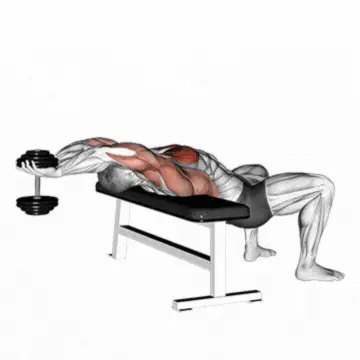Dumbbell Pullover For Chest: Best Form, Faults & 10 Benefits
Build a stronger chest and back with the Dumbbell Pullover. Learn the benefits and how to do it correctly with our comprehensive guide and focus on the Dumbbell Pullover exercise. Follow Learn For Fit For Get Fit.

Step-by-Step Guide for the Dumbbell Pullover:
Start by lying flat on a bench with your head and shoulders off the end.
Grasp a dumbbell with both hands and hold it straight above your chest, with your arms slightly bent.
Lower the weight back over your head, keeping your arms slightly bent and using only your chest and back muscles to control the movement.
Bring the weight back to the starting position, focusing on squeezing your chest and back muscles.
Repeat for the desired number of reps, making sure to maintain good form throughout the exercise.
It’s important to keep the weight light when starting out with the Lying Dumbbell Pullover. As you progress, you can gradually increase the weight to challenge your muscles and see continued progress.
What are the benefits of dumbbell pullovers?
The Lying Dumbbell Pullover is a simple yet effective exercise that targets the chest and back muscles. With the right form and proper weight, this exercise can help you build muscle, increase your strength, and improve your overall fitness. In this article, we’ll take a look at the benefits of the Lying Dumbbell Pullover and show you how to do it correctly.
Increased chest muscle activation: The Lying Dumbbell Pullover is an excellent exercise for targeting the chest muscles, specifically the pectoralis major. This muscle is responsible for moving the arm across the body, making it an essential part of any chest workout.
Improved upper body strength: The Lying Dumbbell Pullover is a compound exercise that works multiple muscle groups, including the chest, triceps, and back muscles. By targeting these muscle groups, this exercise can help you improve your overall upper body strength.
Enhanced flexibility: This exercise requires a large range of motion, which can help increase your flexibility and prevent muscle stiffness.
Better posture: By strengthening the chest and back muscles, the Lying Dumbbell Pullover can help improve your posture and prevent back pain.
Increased endurance: This exercise requires sustained effort and resistance, making it an excellent way to improve your overall endurance and stamina.
Improved breathing: Because this exercise requires a deep inhalation, it can also help improve your breathing and oxygen uptake.
Increased muscle mass: By working your chest and back muscles, this exercise can help you build muscle mass and improve your overall appearance.
Reduced risk of injury: The Lying Dumbbell Pullover is a low-impact exercise that places minimal stress on the joints, reducing the risk of injury.
Versatility: This exercise can be done with a variety of weights and repetition ranges, making it suitable for individuals at all fitness levels.
Increased metabolism: This is a compound exercise that works multiple muscle groups, which can help increase your metabolism and burn more calories.
Here are some common mistakes to avoid when performing dumbbell pullovers:
Arching the Back: One of the most common mistakes is arching the back excessively while performing the exercise. This can cause strain on the lower back and reduce the effectiveness of the exercise. To avoid this, keep your back flat on the bench and engage your core muscles to stabilize your body.
Using Too Much Weight: Another mistake is using too much weight, which can compromise form and lead to injury. Start with a lighter weight and focus on maintaining proper form throughout the exercise.
Overextending the Elbows: When performing dumbbell pullovers, it is important to avoid overextending the elbows. This can cause strain on the elbow joint and increase the risk of injury. Instead, keep a slight bend in the elbows throughout the exercise.
Not Breathing Correctly: Breathing is an important part of any exercise, including dumbbell pullovers. Make sure to inhale deeply as you lower the weight behind your head, and exhale fully as you bring the weight back up.
Not Focusing on the Lats: The dumbbell pullover is primarily an exercise for the latissimus dorsi (lats) muscle, but many people focus too much on the chest or triceps. To maximize the benefits of the exercise, focus on contracting your lats as you bring the weight up and lowering it behind your head.
By avoiding these common mistakes, you can perform dumbbell pullovers safely and effectively to target your back muscles.
Is dumbbell pullover for chest or back?
The dumbbell pullover is an exercise that primarily targets the back muscles, specifically the latissimus dorsi muscle, which is the largest muscle in the back. However, the exercise also works the chest muscles to some extent, particularly when the arms are kept straight during the movement.
While the exercise is primarily used for targeting the back muscles, it can also help to strengthen the chest, triceps, shoulders, and core muscles. Therefore, the dumbbell pullover is a compound exercise that works multiple muscle groups at once, making it a valuable addition to any upper body workout routine.
Do dumbbell pullovers build chest?
While the dumbbell pullover primarily targets the back muscles, it can also work the chest muscles to some extent, particularly when the arms are kept straight during the movement. However, the amount of chest activation during the exercise is relatively small compared to exercises that specifically target the chest, such as bench press or push-ups.
That being said, the dumbbell pullover can still be a useful exercise for developing upper body strength and muscle mass, and it can provide some additional stimulation to the chest muscles. Additionally, incorporating the dumbbell pullover into a well-rounded workout routine that includes exercises specifically targeting the chest, can help to promote overall chest development.
Overall, while the dumbbell pullover is not a primary exercise for building chest muscles, it can still provide some benefits to the chest as well as the back and other upper body muscles.
What muscles does dumbbell pullover work?
The dumbbell pullover is an effective exercise that primarily targets the latissimus dorsi muscle, which is the largest muscle in the back. Additionally, other muscles worked during the exercise include:
Chest: The pectoralis major, or chest muscle, is also activated during the exercise, especially when the arms are kept straight.
Triceps: The triceps brachii muscles located at the back of the upper arm, which are involved in elbow extension, also get worked during dumbbell pullovers.
Shoulders: The shoulder muscles, including the anterior deltoids, get activated to stabilize the shoulder joint during the exercise.
Core Muscles: The core muscles including the abdominals and the lower back, get activated to stabilize the torso during the exercise.
Overall, the dumbbell pullover is an effective exercise for developing the back muscles, particularly the latissimus dorsi, and can also help to strengthen the chest, triceps, shoulders, and core muscles.

